by Sandra Gulland | Jun 8, 2008 | Adventures of a Writing Life |
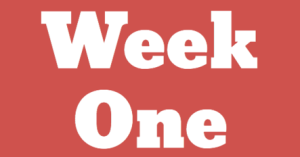
It’s Saturday, I’m in Philadelphia, and I’m one week into my tour. I have more energy now than when I started. In fact, I could get used to this. I’ve seen lots of Connecticut by car, flown from New York to Boston, and gone by train from Boston to Philadelphia.
I’ve signed a zillion books at bookstores—called “signing stock”—and my hand hasn’t given out. I’m a Sharpie fan! All through Connecticut, store clerks would ask, “Do you have a Sharpie?” (Not, “Do you have a pen?”) Kelly Bowen, my publicist would laugh: “She’s got one.”
One clerk didn’t understand that we were there to sign books. He handed me a copy of Mistress of the Sun. “Have you been waiting long for the new Sandra Gulland?”
“I’m Sandra Gulland, and yes, I’ve been waiting long.” It made my day.
Trish Todd, my publisher, warned me that book sales were down throughout the country and that turn-outs might be sparce. There seems always to be enough, though, and invariably there are a few present who are huge fans, who make it all worthwhile.
by Sandra Gulland | May 22, 2008 | Adventures of a Writing Life |
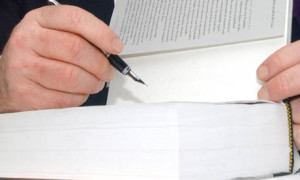
My husband can go in and out of an office supply store in 5 minutes. Not me. Yesterday I had the luxury of time, and I walked all the aisles, lingering. I did have a list: printer inkers, storage boxes (for packing away Mistress of the Sun notes), stick-on dots (for coding the research books on my shelves), but most importantly, a signing pen to use when signing my books.
When my first book was published, my husband gave me a beautiful Waterman fountain pen, which I treasure. But it proved challenging to use as a signing pen: it sometimes blotched, stained my fingers, and it could leak in-flight. Also, and most importantly, I had to carefully blot the signed title page before closing the book. In the beginning, when I had only few books to sign, I welcomed a time-consuming process. Now, when I’m signing as many as 40 books, I need to be more efficient.
What to look for in a signing pen
Recently, I stopped into a Chapters/Indigo store in Toronto, and offered to sign my books. I did not have a pen with me, and I was quickly offered a Sharpie. Well. Not that elegant, but— “They don’t blot,” the clerk told me. “Which is why we use them.” The other nice thing about a felt-tip marker, I later thought, is that you are given notice when it’s drying up—not like a fountain or ball-point pen that can quit mid-signature. Making a mess in a $30 book is not a good thing.
So I lingered long at the felt-tip marker section. It wasn’t an independent office supply store—the wonderful type of store where you can test the pens on a scrap of paper provided—so I purchased a selection, and headed north, to Petawawa Stables, where I had my horse to visit … and a book to sign.
 I’ve known Dawn and her mother Yvonne since before I began writing Mistress of the Sun. I used to take riding lessons there, and my horse, Finnegan, is wonderfully looked after there during the winter.
I’ve known Dawn and her mother Yvonne since before I began writing Mistress of the Sun. I used to take riding lessons there, and my horse, Finnegan, is wonderfully looked after there during the winter.
I was delighted to sign Yvonne’s book, a gift to her from Dawn. I had tested the markers in the car: the Sharpies, a medium tip, were too fat—a fine-point would be a better choice—but the blue Staedtler (1.0 Medium) worked quite nicely … if only I didn’t have to buy a set of eight in assorted colors to get that one blue.
I’ll be in New York soon, with time, I hope, for one of my favorite past-times: lingering in the aisles of an office supply store.
Afternote: I will have more to report on picking out a signing pen soon. Stay posted.
Photo: Finnegan and me, taken by Dawn Townshend at Petawawa Stables.
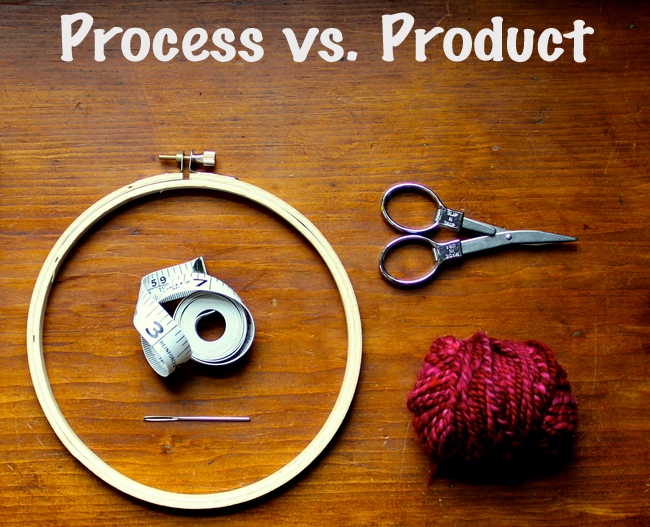
by Sandra Gulland | Apr 18, 2008 | Adventures of a Writing Life |
I talked with a friend last night at a party. She confessed that she had always wanted to write, but that she’s given up. “Now it’s too late.” She is in her early fifties.
Of course I said, It’s never too late … and I believe that to be true. I told her that even one-half hour a day is all it takes … and I believe that to be true, as well.
I woke up this morning thinking of this conversation: thinking, as well, that it came down to process versus product. It’s never too late to engage in the process of writing. But the product: this is what stops people, and I don’t believe that it should.
By product, people think agent, publishing house, editors, production, promotion … all of that. They also assume—although it’s not always the case—that there is profit involved, money to be earned by the writer. Somehow this confers legitimacy. And it does—I’m not going to argue that—but it’s not the only legitimacy.
I think of a book that once meant a great deal to me, in my teens: To Paint is to Love Again, by Henry Miller. (Miller’s full quote is, “To paint is to love again, and to love is to live life to its fullest.”) Although I don’t know for sure, I believe this was initially a self-publication. No doubt I could have an entire blog dedicated to wonderful books that were self-published. Margaret Atwood and friends started a magazine in order to be able to publish their work. Today, self-publishing is an art form: you can have so much control, and it doesn’t cost very much. It’s no longer “vanity publishing” but rather more like an indie movie. And however it’s viewed, it’s a legitimate creation.
Which led me to think of my own long-time dream of “Log Cabin Press.” I can immediately think of a number of titles—all my own, for I have no desire to be applied to by others, to have to accept or reject, to edit the work of others. That becomes work, and this is all about process, and the creative culmination of that process.
The first title that comes to mind is Bone Magic, the short story that became Mistress of the Sun.
Another is The Book of Books, a compendium of essays about my mother, illustrated with her paintings and other creative work.
Another is The Clown’s Mother, a book of memories about my mother’s mother, my grandmother May.
And the last would be Confessions of an Airhead, my own autobiography.
Vanity press? Yes, in a way, because these would all be intensely personal works, but all the more legitimate, for that.
I think, ultimately (and not a little sadly), of the opening lines of a poem, “Undid in the Land of Undone” by Lee Upton:
All the things I wanted to do and didn’t
took so long.
It was years of not doing.
I began writing because I imagined my tombstone with the words, She never got around to it. So: I must ask myself, What’s next? I do want to write at least one more Sun Court novel, but I also want to complete these Log Cabin Press creations … not for profit, not for fame, but for myself, and for those near and dear.
by Sandra Gulland | Apr 8, 2008 | Adventures of a Writing Life |
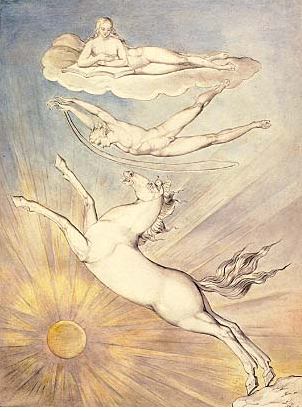 The painting Pegasus by William Blake is an evocative image, I think, for Mistress of the Sun: I see Petite in the clouds, handsome Louis, and, of course, an enchanting white horse. (I would be thrilled if this image was used by a publisher for the cover.)
The painting Pegasus by William Blake is an evocative image, I think, for Mistress of the Sun: I see Petite in the clouds, handsome Louis, and, of course, an enchanting white horse. (I would be thrilled if this image was used by a publisher for the cover.)
I didn’t come across this beautiful painting until Mistress was in production; otherwise, I would have pinned a print above my computer. I have always regarded this novel as something of a fable, and that’s the feeling that this painting gives.
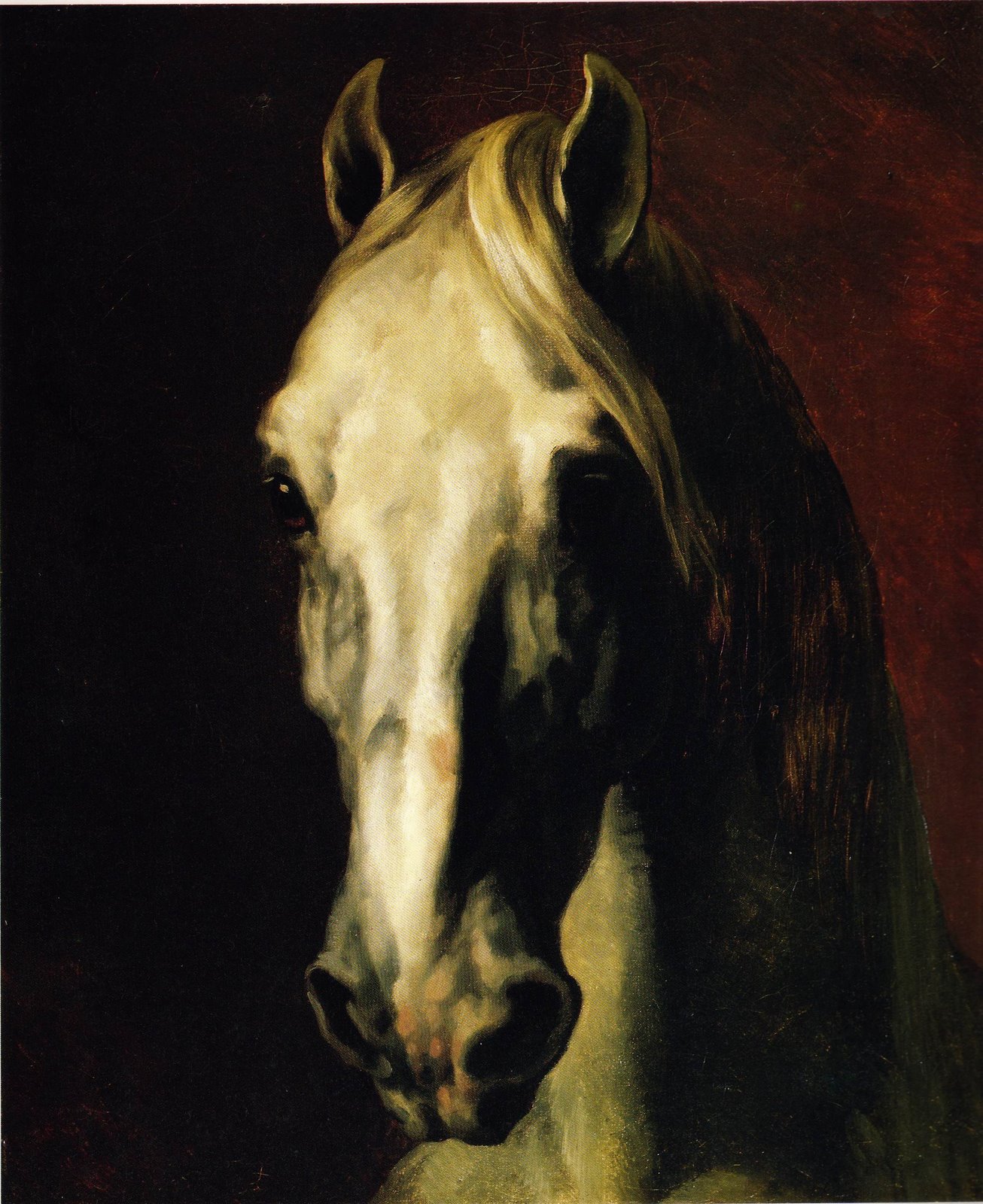 Another painting, also of a white horse “Tête de cheval blanc by Géricault“ was pinned above my desk, and for all those years that I was working on Mistress, I imagined that this image would be the cover.
Another painting, also of a white horse “Tête de cheval blanc by Géricault“ was pinned above my desk, and for all those years that I was working on Mistress, I imagined that this image would be the cover.
“Cover” image, working title, the story itself invariably change, but they are important to me while writing. I write a dedication first thing, as well. This, too, will change over time, but I need to feel that what I’m writing is, in fact, a book, and the more I can approximate one visually, even in the very messy early stages, the more ardently I apply myself to the task at hand.
This image of a white horse was important in other ways; I felt it was my “key” into the novel. I discovered it on a postcard in the Louvre gift shop. I was on my last research trip for The Last Great Dance on Earth. I dreaded finishing that novel, knowing that my long-term and intimate relationship with Josephine and her world would come to an end. I was in tears leaving the room where David‘s magnificent painting of the Coronation of Empress Josephine was displayed at the Louvre.
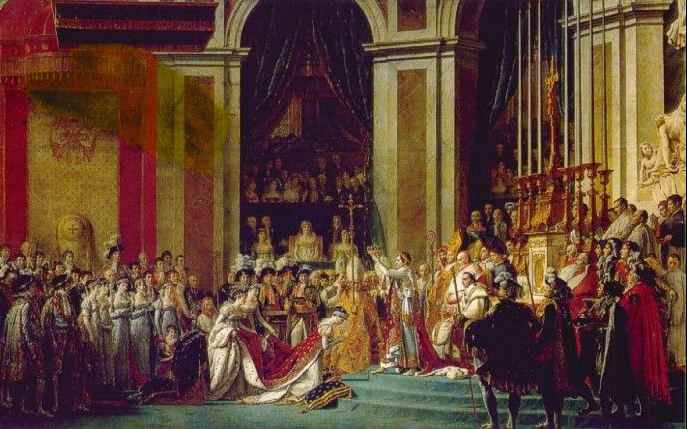 This painting has to be seen to be experienced. It appears life-size. “One walks into it,” Napoleon said. I knew all the characters so well, I felt I was there with them. I also knew that when I returned – if I returned. I would view it as an outsider: hence the tears. As I left the museum, I stopped in the gift shop, needing time to collect before facing the bustling world. I spotted the postcard of Tête de cheval blanc and latched onto it, seeing in it the lifeline to my next novel, my next world.
This painting has to be seen to be experienced. It appears life-size. “One walks into it,” Napoleon said. I knew all the characters so well, I felt I was there with them. I also knew that when I returned – if I returned. I would view it as an outsider: hence the tears. As I left the museum, I stopped in the gift shop, needing time to collect before facing the bustling world. I spotted the postcard of Tête de cheval blanc and latched onto it, seeing in it the lifeline to my next novel, my next world.
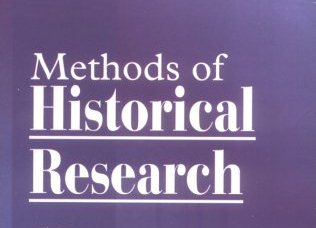
by Sandra Gulland | Mar 27, 2008 | Baroque Explorations |
First, every document I consult is assigned a number. (See my Sun Court bibliography.)
I begin with recording facts— what happened when—to a timeline on a Word file.
I stagger the entries from the point-of-view of the main character: her personal timeline at the far left, then her family and friends, moving across the page with events in the world coming in on the far right.
This way, on any day, I can see more or less what is happening to my character, her loved ones, her enemies, on the political front, etc. Here is a clip from a page of the Trilogy timeline:
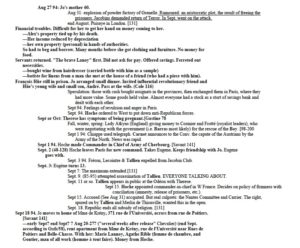 I will usually put my own thoughts, questions, etc. in grey type, and highlight events of particular interest in yellow. I reference each item by document and page number. (Or try to.)
I will usually put my own thoughts, questions, etc. in grey type, and highlight events of particular interest in yellow. I reference each item by document and page number. (Or try to.)
This particular snapshot is of a file created well over a decade ago. For the timeline for Mistress of the Sun—which grew to over 600 pages; there were times when I thought I was writing a timeline, not a novel—I style-coded the entries, which I could then easily re-format and rearrange to reveal the timeline for The Shadow Queen, which is about the same period, but from a different point-of-view.
Recently, for the Young Adult novel I am writing about Josephine‘s daughter Hortense, I began to use Aeon Timeline. This is a nifty Mac software program taylor-made for writers, but for a timeline as detailed as the one for the Trilogy, I’m starting to think I might be better off sticking with my old Word file. I suspect I will bounce back and forth between the two.
For facts about daily life and individuals, I use Notebook, a Mac outlining software program, again referencing details with book and page number. (The Notebook feature on Word is also useful, and I’ve started to use it instead, although the jury’s not yet out on it.)
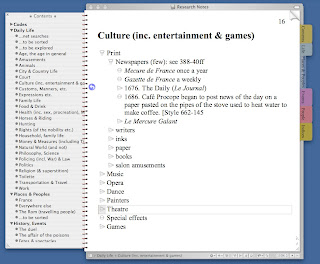
An outlining program such Notebook is useful because I can search it easily. (The search facility on Word is powerful as well, but not as flexible as on Notebook. There are pros and cons for each.)
The important thing about a research method—any research method—is evolving a way to store facts so one can easily find what one needs to know.
I’ve taken to using both Evernote and DevonThink Pro as databases. (See Research Tools.) DevonThink is more powerful, but Evernote is wonderfully handy because I can email documents to it. I photograph text and email it directly to Evernote from iPhoto.
And then, of course, there is what I call experiential research: the travel and other research (such as taking a Baroque dancing class, traveling on horseback, or spending a week in a silent monastery). I generally begin with the academic research; then, once I’ve written a draft and know what I need to know, I begin the travel and other research. I write many drafts, continuing to research as I go. If I hit a dry spell, research will invariably replenish me.
(Note: see also the research page on my website.)











